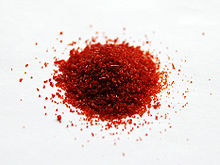Nitroprusside
| Structural formula | |||||||||||||||||||
|---|---|---|---|---|---|---|---|---|---|---|---|---|---|---|---|---|---|---|---|

|
|||||||||||||||||||
| General | |||||||||||||||||||
| Surname | Nitroprusside | ||||||||||||||||||
| other names |
|
||||||||||||||||||
| Molecular formula | Na 2 [Fe (CN) 5 NO] • 2 H 2 O | ||||||||||||||||||
| Brief description |
ruby red rhombic crystals |
||||||||||||||||||
| External identifiers / databases | |||||||||||||||||||
|
|||||||||||||||||||
| Drug information | |||||||||||||||||||
| ATC code | |||||||||||||||||||
| properties | |||||||||||||||||||
| Molar mass | 297.95 g mol −1 | ||||||||||||||||||
| Physical state |
firmly |
||||||||||||||||||
| density |
1.72 g cm −3 |
||||||||||||||||||
| solubility |
soluble in water and ethanol |
||||||||||||||||||
| safety instructions | |||||||||||||||||||
|
|||||||||||||||||||
| As far as possible and customary, SI units are used. Unless otherwise noted, the data given apply to standard conditions . | |||||||||||||||||||
Nitroprusside (also sodium nitroprusside or nitroprusside sodium ) is an inorganic compound from the class of active substances called cyanides . In intensive care medicine , it is used as a medicinal substance for short-term lowering of blood pressure in hypertensive crises or during operations.
properties
Sodium nitroprusside occurs in the form of ruby red crystals. The formula is Na 2 [Fe (CN) 5 NO] · 2 H 2 O. It contains iron in the Fe 2+ oxidation state , and NO as a NO + ligand .
Nitroprusside is considered to be the strongest blood pressure lowering substance and works by releasing nitric oxide (NO) in the smooth muscles, including the vascular wall. It leads to a strong vasodilation mainly of the arteries with a decrease of the peripheral resistance , but also of the veins . Due to the strong antihypertensive effect and the short half-life of less than ten minutes, continuous intravenous administration under intensive medical supervision is necessary.
Use in medicine
Nitroprusside is primarily used to treat patients with aortic dissection , aortic stenosis , acute aortic insufficiency and severe heart failure . In hypovolemic patients, there may be a marked reduction in stroke volume and ventricular filling. Nitroprusside can only be given if there is sufficient intravascular volume.
The injection solution consisting of nitroprusside sodium powder for injection purposes and 5% dextrose (glucose) is slightly yellow and remains stable for about 24 hours if it is B. is protected from light by aluminum foil. Otherwise the active ingredient oxidizes , which leads to a loss of effectiveness. For exact dosage (10 to 100 µg / min in adults, maximum 8 µg / kg / min and maximum 1 mg / kg / day) and because of the recommendation not to mix nitroprusside with other drugs or solutions, it is usually used with Infused with the help of a syringe pump via its own vein access.
After prolonged use, sodium thiosulfate is added for detoxification because of the release of cyanide .
Use in chemical analysis
In chemical analysis , sodium nitroprusside is used to detect sulfide ions . In a solution that is not too alkaline ( sodium carbonate solution ), a purple color appears when freshly prepared 1% solution is added, which disappears again on acidification.
The reaction taking place in the alkaline environment contains various intermediate states and is as follows:
HS - + [Fe (CN) 5 NO] 2- → [Fe (CN) 5 NO-HS] 3- ⇌ [Fe (CN) 5 NO-S] 4- + H +
A red precipitate of Zn 2 [Fe (CN) 5 SO 3 ] forms with sulfite ions in the presence of zinc ions .
Finished medicinal products
Nipruss (D), Nitropress (USA), Nipride
See also
literature
- Khot UN et al .: Nitroprusside in critically ill patients with left ventricular dysfunction and aortic stenosis . New England Journal of Medicine (2003) 348: 1756-1763. PMID 12724481 .
- Reinhard Larsen: Anesthesia and intensive medicine in cardiac, thoracic and vascular surgery. (1st edition 1986) 5th edition. Springer, Berlin / Heidelberg / New York et al. 1999, ISBN 3-540-65024-5 , pp. 65-68 and 76 f.
Individual evidence
- ↑ a b Entry on sodium nitroprusside. In: Römpp Online . Georg Thieme Verlag, accessed on May 27, 2014.
- ↑ Nitroprusside data sheet from AlfaAesar, accessed on March 14, 2010 ( PDF )(JavaScript required) .
- ↑ a b Sodium nitroferricyanide (III) dihydrate data sheet from Sigma-Aldrich , accessed on May 13, 2017 ( PDF ).
- ^ AF Holleman , E. Wiberg , N. Wiberg : Textbook of Inorganic Chemistry . 91st – 100th, improved and greatly expanded edition. Walter de Gruyter, Berlin 1985, ISBN 3-11-007511-3 , p. 1144.
- ↑ Reinhard Larsen: Anesthesia and intensive medicine in cardiac, thoracic and vascular surgery. 1999, pp. 76, 239 and 243 f.
- ↑ Jander-Blasius: Textbook of analytical and preparative inorganic chemistry, S. Hirzel Verlag Stuttgart, 5th edition 1965, p. 130
- ↑ Sandra L. Quiroga, Alejandra E. Almaraz, Valentín T. Amorebieta, Laura L. Perissinotti, José A. Olabe: Addition and Redox Reactivity of Hydrogen Sulfides (H2S / HS -) with Nitroprusside: New Chemistry of Nitrososulfide Ligands . In: Chemistry - A European Journal . tape 17 , no. 15 , April 4, 2011, ISSN 0947-6539 , p. 4145-4156 , doi : 10.1002 / chem.201002322 ( wiley.com [accessed August 26, 2020]).
- ↑ Hans Peter Latscha, Gerald W. Linti, Helmut Alfons Klein: Analytische Chemie , Springer, Berlin, 4th edition, 2004, p. 52 ( limited preview in Google book search).


![{\ displaystyle \ mathrm {[Fe (CN) _ {5} NO] ^ {2 -} + S ^ {2 -} \ longrightarrow [Fe (CN) _ {5} NOS] ^ {4-}}}](https://wikimedia.org/api/rest_v1/media/math/render/svg/36648c548b3be2a0c6cc67d0e3cdb3b664eeefed)